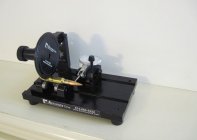You are using an out of date browser. It may not display this or other websites correctly.
You should upgrade or use an alternative browser.
You should upgrade or use an alternative browser.
Concentricity Gauge
- Thread starter praveen
- Start date
just bend the bullet into alignment with your fingers, against the bench, or with a piece of small tube.
Keep in mind that the many guns will tip the bullet over on extraction.
Honestly, unless you are shooting mice at 200 yrds, or benchresting, run out is a non-issue. You should use it as a diagnostic of your loading gear. Even top shelf seating dies can be made poorly and have run out, though it is also commonly caused by the expander ball on the decapping pin dragging the neck to one side when you lower the ram.
Most guns, and most shooters will not notice a bit of run out. If the case neck fits the chamber well, and the bullet is up near the lands, it will straighten out just fine when you shot it. Try not to get to worked up about your ammo.
If you shoot one round at a time over a bench, and your goal is to make the smallest hole possible, then worry about it. If you are just making ammo to have fun with of hunt rabbits at 200yrds, ignore it unless it is bad enough to notice with out the gauge.
Keep in mind that the many guns will tip the bullet over on extraction.
Honestly, unless you are shooting mice at 200 yrds, or benchresting, run out is a non-issue. You should use it as a diagnostic of your loading gear. Even top shelf seating dies can be made poorly and have run out, though it is also commonly caused by the expander ball on the decapping pin dragging the neck to one side when you lower the ram.
Most guns, and most shooters will not notice a bit of run out. If the case neck fits the chamber well, and the bullet is up near the lands, it will straighten out just fine when you shot it. Try not to get to worked up about your ammo.
If you shoot one round at a time over a bench, and your goal is to make the smallest hole possible, then worry about it. If you are just making ammo to have fun with of hunt rabbits at 200yrds, ignore it unless it is bad enough to notice with out the gauge.
CatShooter
praveen_4 said:So, say I use a concentricity gauge and find some runout in the loaded rounds or the empty cases.
How do you then fix it? Knowing that there is some runout is great but what do you do after that finding?
First, pay no attention to Joshua... he lives on a different planet.
OK, the real first - Start with the fired cases... check them for neck run-out, before you do anything else. If the chambering was OK, then this is easy - extracted cases are usually dead on concentric.
Then size them, and check the neck run-out... if you FL size or neck size, measure a few sized without the expander ball and a few sized WITH the expander ball.
The do the same when the bullets are seated... check the neck AND bullet run-out.
Check every stage to find out where/when run-out is being introduced into your chain of efforts. Then deal with that stage.
CatShooter said:praveen_4 said:So, say I use a concentricity gauge and find some runout in the loaded rounds or the empty cases.
How do you then fix it? Knowing that there is some runout is great but what do you do after that finding?
First, pay no attention to Joshua... he lives on a different planet.
OK, the real first - Start with the fired cases... check them for neck run-out, before you do anything else. If the chambering was OK, then this is easy - extracted cases are usually dead on concentric.
Then size them, and check the neck run-out... if you FL size or neck size, measure a few sized without the expander ball and a few sized WITH the expander ball.
The do the same when the bullets are seated... check the neck AND bullet run-out.
Check every stage to find out where/when run-out is being introduced into your chain of efforts. Then deal with that stage.
Not to quibble, but you just told him to use it as a diagnostic tool, which is exactly what I told him
And you blamed the same things I did as the cause.
Maybe you think a bit of run out makes a difference in anything other than a match barrel? Unless the chamber is tight, and the brass and sizer are matched properly to the barrel, and the ammo has no or very light crimp, run out is a non issue since the whole cartridge does not fit correctly. Just roll the cartridge across the table and if the point bobs up an down, push it over with your finger til it rolls right. You can always spend a few hundred bucks on a concentricity gauge that has a ram for fixing it though.
bigedp51
More ammunition is reloaded with excessive runout simply because the expander button is locked down off center than any other cause with standard off the shelf dies.
Below a standard RCBS full length die using a Forster expander button assembly that has a rubber washer above the lock nut. This allows it to float and self center, also the expander button is located high on the spindle and the neck of the case is still inside the neck of the die when the expander button enters the neck.

The above setup is capable of under .001 runout with good brass, note the military conceders .003 or less runout "match grade" ammunition.
You can't make a silk purse from a sows ear, so a neck thickness gauge "along" with a good runout gauge is a must for sorting the cases.
The case below has .004 variation in neck thickness which adds to your runout problem and the neck thickness will help in your detective work hunting down the cause of the runout.


Below are two concentricity gauges, the Hornady gauge in the rear is for bending cheaply made ammo for my AR15s, meaning cases with unequal wall and neck thicknesses.

As CatShooter and others have said above find the source of your runout and fix the problem before it is a problem. If your groups are still large I blame it on drinking too much coffee, cataracts and a dyslexic trigger finger. ;D
Below a standard RCBS full length die using a Forster expander button assembly that has a rubber washer above the lock nut. This allows it to float and self center, also the expander button is located high on the spindle and the neck of the case is still inside the neck of the die when the expander button enters the neck.

The above setup is capable of under .001 runout with good brass, note the military conceders .003 or less runout "match grade" ammunition.
You can't make a silk purse from a sows ear, so a neck thickness gauge "along" with a good runout gauge is a must for sorting the cases.
The case below has .004 variation in neck thickness which adds to your runout problem and the neck thickness will help in your detective work hunting down the cause of the runout.


Below are two concentricity gauges, the Hornady gauge in the rear is for bending cheaply made ammo for my AR15s, meaning cases with unequal wall and neck thicknesses.

As CatShooter and others have said above find the source of your runout and fix the problem before it is a problem. If your groups are still large I blame it on drinking too much coffee, cataracts and a dyslexic trigger finger. ;D
Joe R
Gold $$ Contributor
First do what Catshooter says, however, if after you've identified the source of the runout you may get some that still have more runout than you'd like you can use the Hornady Concentricity tool. Don't be fooled by the dial indicator, it's worthless, but it can help you tweak most rounds into a better configuration.
See below
See below
Attachments
praveen_4 said:Thanks guys. All this gave me a lot of pointers and I am looking at getting the 21st century concentricity gauge.
+1 that is a good selection.
My rifles are happier with sub 0.005" run-out. I had a seater die that despite all the tricks gave anywhere from 0.001" to 0.014" run-out... Polishing the Seater stem to fit the bullet really reduced that, but I did learn that 0.010" and over will make a sub-MOA rifle into a hyper-MOA rifle.
Joe R
Gold $$ Contributor
praveen_4
Thanks guys. All this gave me a lot of pointers and I am looking at getting the 21st century concentricity gauge.
I don't know how serious you are about checking runout. I do it for every round, so ease, accuracy and repeatability are essential. This is the one I use, and here's a video of it in action. It's a bit expensive, but I've used on about 4,000 thousands cases last year, so it has earned its keep. https://www.youtube.com/watch?v=UukFQTa6Gws
Attachments
waltk
Gold $$ Contributor
Joe R said:praveen_4
Thanks guys. All this gave me a lot of pointers and I am looking at getting the 21st century concentricity gauge.
I don't know how serious you are about checking runout. I do it for every round, so ease, accuracy and repeatability are essential. This is the one I use, and here's a video of it in action. It's a bit expensive, but I've used on about 4,000 thousands cases last year, so it has earned its keep. https://www.youtube.com/watch?v=UukFQTa6Gws
This gauge is Very Expensive but I agree it is the best.
michaelnel
Old and In The Way
21st Century just came out with a wheel for their excellent concentricity tool:


michaelnel said:21st Century just came out with a wheel for their excellent concentricity tool:

Can't go wrong with 21st, they make great stuff!!!
michaelnel
Old and In The Way
I ordered the wheel this morning as soon as I saw it. Everything I have bought from 21st Century has been terrific.
Raythemanroe
Bullet Whisperer
I don't agree with straightening a bullet after it is seated, theoretically you are gonna push the case out of shape and or mess with neck tension.. I would diagnose the problem and start from that..
Ray
Ray
Similar threads
- Replies
- 32
- Views
- 3,741
Upgrades & Donations
This Forum's expenses are primarily paid by member contributions. You can upgrade your Forum membership in seconds. Gold and Silver members get unlimited FREE classifieds for one year. Gold members can upload custom avatars.

Click Upgrade Membership Button ABOVE to get Gold or Silver Status.
You can also donate any amount, large or small, with the button below. Include your Forum Name in the PayPal Notes field.
To DONATE by CHECK, or make a recurring donation, CLICK HERE to learn how.

Click Upgrade Membership Button ABOVE to get Gold or Silver Status.
You can also donate any amount, large or small, with the button below. Include your Forum Name in the PayPal Notes field.
To DONATE by CHECK, or make a recurring donation, CLICK HERE to learn how.











